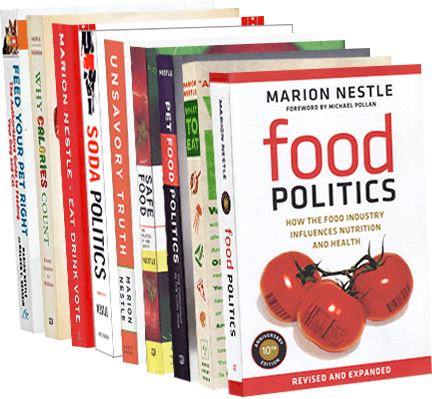IOM Front-of-Package Label Committee releases Phase 1 report
The Institute of Medicine (IOM) released its first Front-of-Package (FOP) labeling report this morning. Phase I is a tough, detailed examination of about 20 of the existing FOP schemes along with some recommendations about what such schemes ought to do.
FOP labels are those little spots, check marks, and tokens that are all over food packages these days and that are supposed to indicate that the product is especially healthy for you. They may seem utterly trivial, but they are of desperate importance to food companies. FOP labels sell food products. Food marketers love them and need them. The FDA worries that having so many of them confuses the public, and that the schemes are based on criteria that serve industry purposes more than to promote public health.
As the IOM press release explains:
A multitude of nutrition rating, or guidance, systems have been developed by food manufacturers, government agencies, nutrition groups, and others in recent years with the intent of helping consumers quickly compare products’ nutritional attributes and make healthier choices. Ratings are typically communicated to shoppers through symbols placed prominently on food packaging, usually on the front, or on retail shelf tags. Unlike the Nutrition Facts panel, these rating systems and symbols are unregulated, and different systems focus on different nutrients. The variation may confuse consumers, and questions have been raised about the systems’ underlying nutritional criteria.
The committee did a terrific analysis of current FOP schemes. My favorite parts are its
- Clear, concise histories of nutrition and FOP labeling (students: take note!)
- Detailed evaluation of the strengths (few) and weaknesses (many) of the existing schemes
- Demonstration of the inconsistent results of applying the schemes to specific foods
The report gives examples of the inconsistent results of three scoring schemes: Guiding Stars, NRFI [Nutrient-Rich Foods Index], and Nu-Val
- Instant oatmeal received 3 Guiding Stars, and scores of 87 by NRFI and 39 by NuVal.
- Non-instant oatmeal received 2 Guiding Stars, and scores of 22 by NRFI and 57 by NuVal
- Toasted oat cereal received 2 Guiding Stars, and scores of 84 by NRFI and 37 by NuVal
- Fat free milk, 1% fat milk, and fat free plain yogurt received 3 Guiding Stars, but fat free milk was scored 56 by NRFI and 91 by NuVal; 1% fat milk was scored 30 by NRFI and 81 by NuVal, and fat free plain yogurt was scored 43 by NRFI and 96 by NuVal.
The committee’ key recommendation: FOP labels should deal with just four nutrients: calories, saturated fat, trans fat, and sodium.
These nutrients, says the committee, “are routinely overconsumed and associated most strongly with diet-related health problems affecting many Americans, including obesity, heart disease, high blood pressure, Type 2 diabetes, and certain types of cancer.”
Comment: Trans fat seems unnecessary here. It is already out of most packaged foods. Or maybe the committee thinks that leaving it off will give food companies permission to put hydrogenated oils back in?
The committee chose not to add sugars to this list:
The committee concurred that both added and naturally occurring sugars contribute to the caloric content of foods and beverages and overconsumption of high-calorie products can lead to obesity. Highlighting calories per serving in nutrition rating systems would address this concern.
Comment: I think consumers want to know about added sugars in food products. I certainly do.
Phase II comes next
It will examine designs and look at consumer understanding of the labels, and will discuss “the pros and cons of having a single, standardized front-label food guidance system that is regulated by the Food and Drug Administration.”
Presumably, Phase II will deal with questions that are not addressed in the Phase I report:
- Will this scheme supersede all of the other labeling systems currently on food packages?
- Will it be voluntary or mandatory? For all food products, or just selected ones?
- If the scheme is voluntary, why would food companies choose to use it since it mostly highlights the negatives—the nutrients to be avoided?
- How will it affect the nutrient-content claims currently on food packages? (Examples: “Contains 8 vitamins!” “100% vitamin C!” “High fiber!”)
- How will it affect shelf-labeling schemes such as the Nu-Val system used at Price Chopper supermarkets and the ANDI system used by Whole Foods?
FOP labels are about marketing, not health
This scheme, like the many others developed by food companies singly or together, is designed to help the public decide whether one highly processed, packaged food product is nutritionally better than another.
As I have discussed many times on this site, this approach raises a philosophical question: Is a slightly “better for you” food product necessarily a good choice?
I hope the committee will ponder this and some of my other questions as it enters Phase II.
Addendum: I gather from what I’ve heard about the press conference this morning that some of my questions were answered. The FOP proposal will not affect nutrient content claims on the front of packages. Companies will still be able to proclaim the nutritional benefits of their products in words and banners. They just won’t be able to use them in whatever symbol gets chosen. So what difference will this report make? Not much, alas, except to get rid of the silly symbols in use right now.
Update, October 14: William Neuman’s account of this event in the New York Times starts with this: “Tell us how your products are bad for us.”

